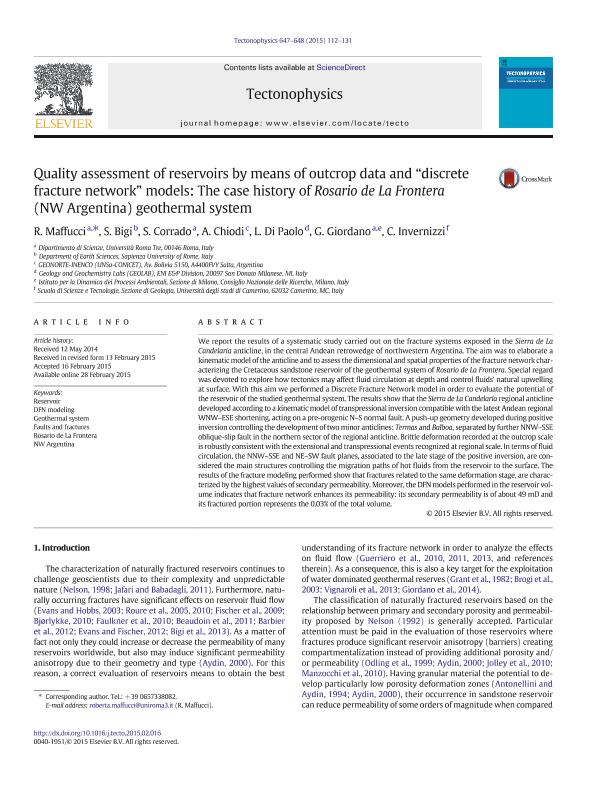Artículo
Quality assessment of reservoirs by means of outcrop data and "discrete fracture network" models: the case history of Rosario de La Frontera (NW Argentina) geothermal system
Maffucci, Roberta; Bigi, Sabina; Corrado, Sveva; Chiodi, Agostina Laura ; Di Paolo, Lea; Giordano, Guido; Invernizzi, Chiara
; Di Paolo, Lea; Giordano, Guido; Invernizzi, Chiara
 ; Di Paolo, Lea; Giordano, Guido; Invernizzi, Chiara
; Di Paolo, Lea; Giordano, Guido; Invernizzi, Chiara
Fecha de publicación:
28/02/2015
Editorial:
Elsevier
Revista:
Tectonophysics
ISSN:
0040-1951
http://dx.doi.org/10.1016/j.tecto.2015.02.016
http://dx.doi.org/10.1016/j.tecto.2015.02.016
Idioma:
Inglés
Tipo de recurso:
Artículo publicado
Clasificación temática:
Resumen
We report the results of a systematic study carried out on the fracture systems exposed in the Sierra de La Candelaria anticline, in the central Andean retrowedge of northwestern Argentina. The aim was to elaborate a kinematic model of the anticline and to assess the dimensional and spatial properties of the fracture network characterizing the Cretaceous sandstone reservoir of the geothermal system of Rosario de La Frontera. Special regard was devoted to explore how tectonics may affect fluid circulation at depth and control fluids' natural upwelling at surface. With this aim we performed a Discrete Fracture Network model in order to evaluate the potential of the reservoir of the studied geothermal system. The results show that the Sierra de La Candelaria regional anticline developed according to a kinematic model of transpressional inversion compatible with the latest Andean regional WNW–ESE shortening, acting on a pre-orogenic N–S normal fault. A push-up geometry developed during positive inversion controlling the development of two minor anticlines: Termas and Balboa, separated by further NNW–SSE oblique-slip fault in the northern sector of the regional anticline. Brittle deformation recorded at the outcrop scale is robustly consistent with the extensional and transpressional events recognized at regional scale. In terms of fluid circulation, the NNW–SSE and NE–SW fault planes, associated to the late stage of the positive inversion, are considered the main structures controlling the migration paths of hot fluids from the reservoir to the surface. The results of the fracture modeling performed show that fractures related to the same deformation stage, are characterized by the highest values of secondary permeability. Moreover, the DFN models performed in the reservoir volume indicates that fracture network enhances its permeability: its secondary permeability is of about 49 mD and its fractured portion represents the 0.03% of the total volume.
Archivos asociados
Licencia
Identificadores
Colecciones
Articulos(INENCO)
Articulos de INST.DE INVEST.EN ENERGIA NO CONVENCIONAL
Articulos de INST.DE INVEST.EN ENERGIA NO CONVENCIONAL
Citación
Maffucci, Roberta; Bigi, Sabina; Corrado, Sveva; Chiodi, Agostina Laura; Di Paolo, Lea; et al.; Quality assessment of reservoirs by means of outcrop data and "discrete fracture network" models: the case history of Rosario de La Frontera (NW Argentina) geothermal system; Elsevier; Tectonophysics; 647-648; 28-2-2015; 112-131
Compartir
Altmétricas



